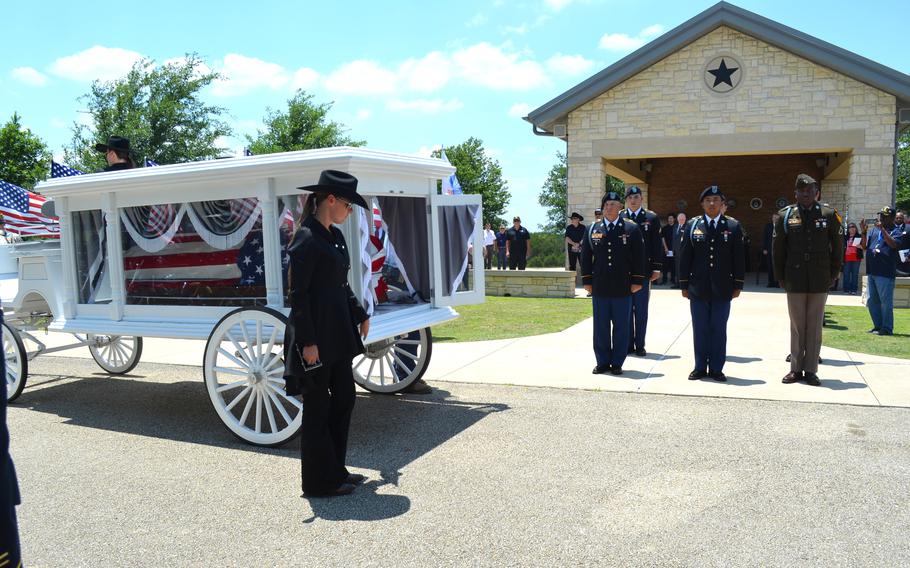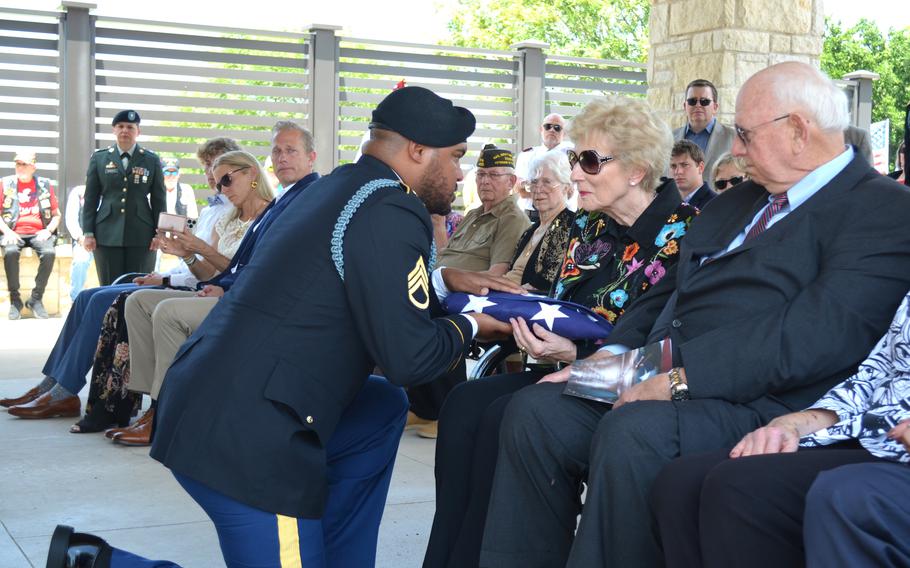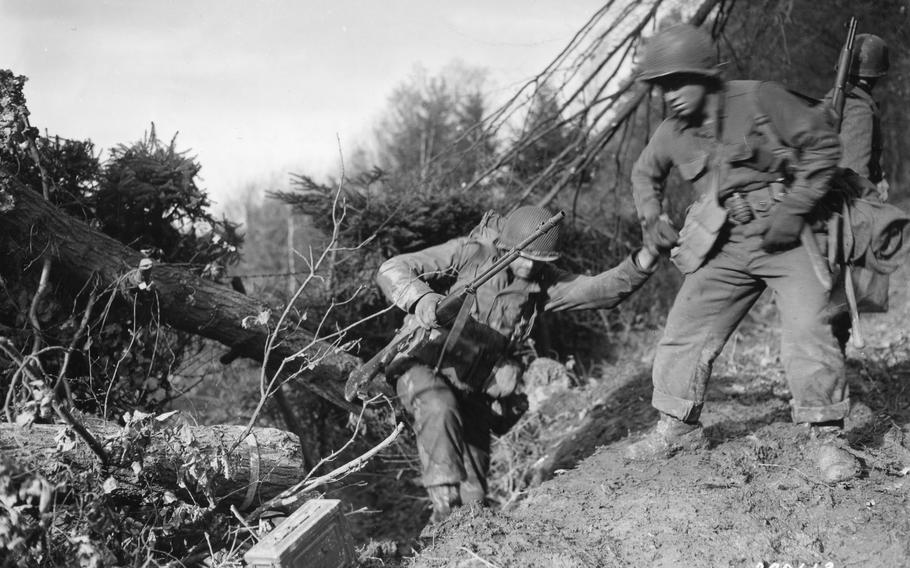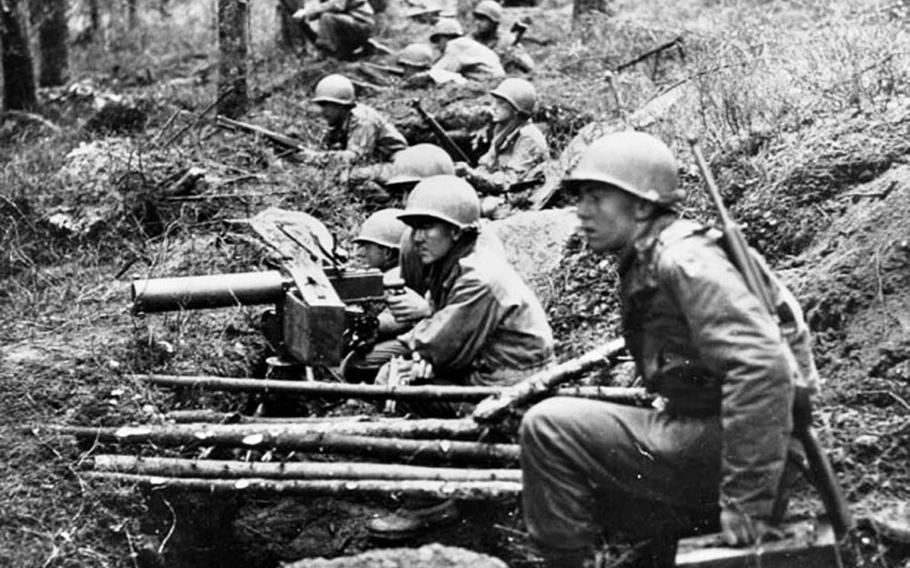
Soldiers prepare to carry the casket of Pvt. Myron Elton Williams at Central Texas State Veterans Cemetery in Killeen, Texas, on June 2, 2023. Williams died in November 1944 during the Battle of Hurtgen Forest in Germany during World War II, but his remains were only identified July 22, 2022. ( Rose L. Thayer/Stars and Stripes)
KILLEEN, Texas — The Army’s 4th Infantry Division landed on the beaches of Normandy, France, on June 6, 1944, and had already suffered several thousand casualties by the time it began the Battle of Hurtgen Forest in Germany just three months later.
Pvt. Myron Elton Williams landed on D-Day with the division and served as a member of Company L in the 12th Infantry Regiment. But, on Nov. 16, 1944, the 30-year-old went into a heavily mined area of the forest and was never seen again.
Nearly 79 years since that day, relatives who Williams never had the chance to meet laid him to rest Friday at the Central Texas Veterans Cemetery in Killeen.
“He is home,” said Capt. Joseph Anaman, an Army chaplain from nearby Fort Cavazos who presided over the burial ceremony. Dozens gathered in the cemetery to pay respects to Williams and his distant relatives.
Known by his middle name Elton, the soldier was survived at the time of his death by his wife Dorothy Havener Williams, and his five sisters. Williams’ niece Dianne Mangum, 78, accepted the task of planning the service as his oldest, closest living relative.

Dianne Mangum accepts a flag to honor her uncle Pvt. Myron Elton Williams at Central Texas State Veterans Cemetery in Killeen, Texas, on June 2, 2023. Williams died in November 1944 during the Battle of Hurtgen Forest in Germany during World War II, but his remains were only identified July 13, 2022. (Rose L. Thayer/Stars and Stripes)
“I never heard of my uncle. They never talked about him,” Mangum said. “After the war, the sisters’ husbands all came back to different places and spread out.”
About four years ago, the Defense POW/MIA Accounting Agency contacted Mangum to submit her DNA to possibly help identify Williams, which she did. On July 13, 2022, DPAA confirmed they had confirmed the full skeletal remains of her uncle.
Through a four-hour meeting with DPAA in her Austin home in March, Mangum said she learned all about Williams’ time in World War II and the efforts during the last nearly 80 years to find his remains and return him to American soil.
Williams was born May 4, 1915, in Ottawa, Ill., and entered the Army on Sept. 17, 1943. Four months later, he found himself in England where preparations were underway for the D-Day invasion the following month, according to his obituary.
In September, his unit went into battle against German forces in the Hurtgen Forest. The battle is considered the longest in American history. It ended after about six months when German forces launched its last major offensive of the war known as the Battle of Bulge.
Hurtgen Forest is known to have cost the lives of more than 33,000 American troops, said Mark Calhoun, an historian at the Institute for the Study of War and Democracy at the National World War II Museum in New Orleans, La. Some estimates have the number of casualties closer to 50,000, he said.
When artillery shells and mortars hit the treetops of the dense forest, it rained down metal shrapnel and wood splinters, a deadly combination that no amount of training could prepare a soldier to survive, Calhoun said.
“They call it airbursts,” he said. “The only way to protect yourself from airbursts is to dig in and put overhead cover above you. If you're attacking you have to get out of your foxhole and move forward.”

Army Pfc. Benny Barrow of St. Louis, Missouri, gives a helping hand to a buddy as they make a difficult climb in the Hurtgen Forest in Germany during World War II. ( National Archives)
The terrain below was muddy and steep and the cold weather was exacerbated by a lack of appropriate gear and supplies, Calhoun said. Then there were the dense bands of minefields, coiled barbed wire and booby traps with hanging mines that dropped down when the wire was cut.
On the day that Williams died, the 12th Infantry Regiment had just received a new group of soldiers and had begun to move to take the Cologne Plain, which was about 300 yards away. After four days, half of the 120 riflemen in Company L had died.
“The rate of casualties is just really mind boggling,” Calhoun said. “That’s what they were up against.”
In 2016, DPAA historians determined about 200 soldiers who fought and died in Hurtgen Forest were still missing, said Traci Van Deest, a forensic anthropologist with DPAA who leads the laboratory efforts to identify soldiers from the Battle of Hurtgen Forest.
Since then, DPAA has identified 57 missing service members, she said. Some of the missing troops’ remains have yet to be collected from the forest.
Van Deest said she recently visited the Hurtgen Forest and experienced for herself the difficult terrain where troops fought. She saw the remnants of the foxholes where troops lived and took shelter.
“It was extremely powerful and very humbling to actually walk in their footsteps through the forest and [see] how these units moved through the trees,” she said. “With identifications that we have done, I was able to stand in the same spot and know that that was the place where an individual fell, and over 75 years later, we were able to say we finally have given you a name and brought you home.”

Members of the 22nd Infantry Regiment holding the line during heavy fighting in the Battle of the Hurtgen Forest on Dec. 1, 1944. (U.S. Army Signal Corps)
Mangum said learning about the battle and the experience of her uncle, and her father and other relatives who fought in World War II, has been surreal.
“It seemed a long time ago,” she said. “But now it is immediate.”